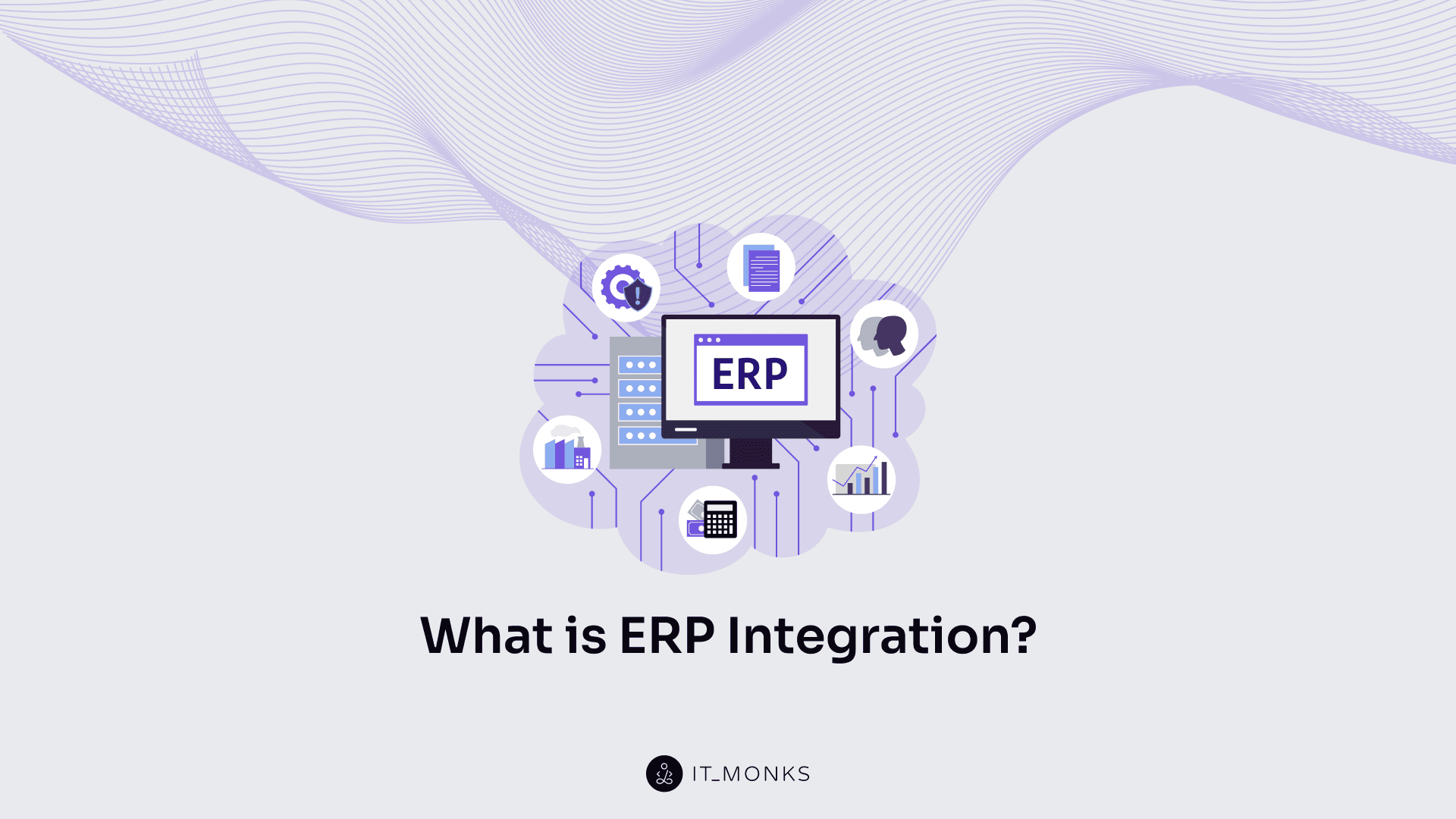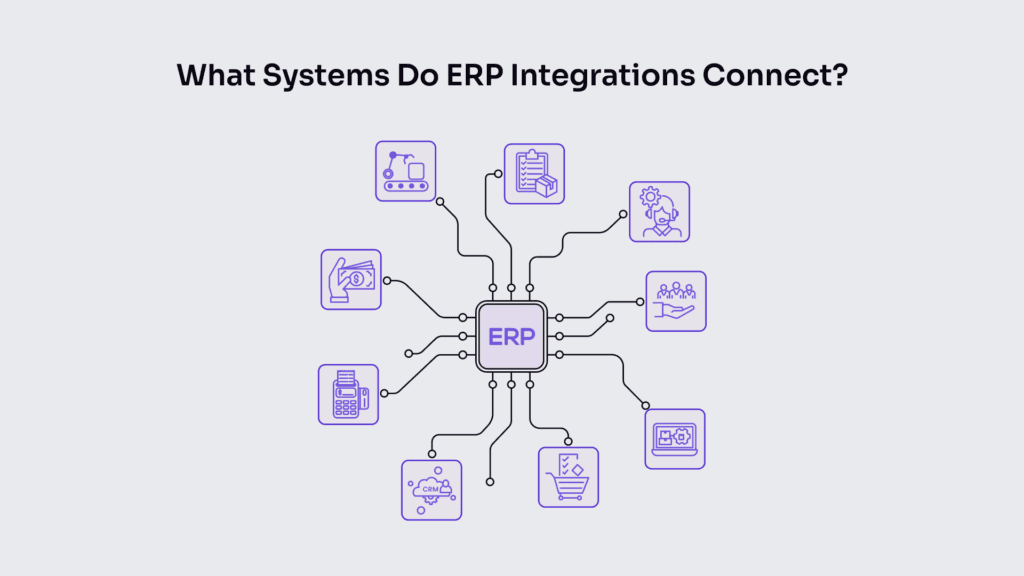What is ERP Integration?
Table of Contents

ERP integration is the process of connecting an Enterprise Resource Planning system with other software applications, databases, and external systems to enable data exchange and process-level integration across an enterprise.
ERP integration works by establishing system interfaces, often through APIs and middleware logic, that serve as a data sync layer, ensuring information flows consistently and accurately between platforms such as CRM, HRM, inventory management, sales, eCommerce, and supply chain management systems.
Enterprise resource planning typically uses middleware solutions or integration platforms (such as ESB or iPaaS) to translate and sync data between systems, so everything works together and data stays up-to-date. Key attributes of ERP integration include unified data management, automated workflows, and real-time visibility, all made possible by reliable system interfaces and a strong data sync layer.
For enterprise companies, ERP integration brings big benefits: it removes data silos, streamlines processes, and helps leaders make better decisions using accurate and up-to-date information.
The main challenges for ERP systems are data compatibility, security, complexity, cost, and the need for skilled professionals. Integration specialists who understand middleware logic, process mapping, and secure system interface design are essential to handle these challenges and ensure a smooth integration process.
What Systems Do ERP Integrations Connect?
ERP integrations connect diverse systems, including core internal systems, external web interfaces, and administrative systems, to simplify and automate data exchange.

Core Internal Systems in ERP Integration
A core internal system in ERP integration is a cohesive collection of interfaces, software, and hardware designed to operate as a functional unit, supporting essential business operations such as finance, sales, inventory, and logistics.
A core internal system ensures smooth data flow, reduces manual errors, and enables real-time visibility across departments. Data processed in ERP integrations includes customer records, sales orders, invoices, inventory levels, and payment statuses.
For example, integrating core internal systems, such as ERP with CRM platforms like Salesforce or HubSpot, merges customer data, improves sales tracking, and customer service. Linking ERP to accounting software such as QuickBooks or Xero automates financial reporting and payment reconciliation. ERP-to-inventory and logistics connections manage stock levels, order fulfillment, and shipment tracking in real time, minimizing errors and delays.
External Web Interfaces in ERP Architecture
External web interfaces are the connections between ERP systems and external entities, such as other applications, web services, or user-facing portals, using standardized methods, protocols, and data formats to exchange information and execute transactions.
External web interfaces allow ERP platforms to interact with e-commerce sites, client portals, or business intelligence dashboards, supporting automation, data consistency, and improved business processes.
Data processed through external web interfaces in ERP integration often includes orders, inventory, customer details, invoices, analytics, and real-time operational metrics.
For instance, ERP-to-ecommerce integrations with Shopify or WooCommerce synchronize inventory, orders, and customer data, ensuring smooth online transactions. ERP connections to client-facing web apps provide customers with self-service access to account details, order status, and billing.
Integrating ERP with business intelligence dashboards enables advanced analytics and reporting, giving stakeholders actionable insights drawn from company-wide data.
Administrative Systems in ERP
Administrative systems are the specialized software and infrastructure that manage an organization’s core internal functions. Integrating administrative software with an ERP centralizes data, streamlines workflows, and provides a unified view of critical operational information. This connection eliminates manual data entry, reduces errors, and enables better, faster decision-making by ensuring data consistency across the enterprise.
For instance, an ERP integration processes data like employee records, payroll figures, time-off requests, and internal communication updates.
Examples of administrative systems in ERP include HRIS (Human Resource Information System), which manages employee data, a payroll system that automates salary calculations, tax filings, and payment distribution, and internal portals that provide centralized access to company information, policies, and self-service tools for employees.
How ERP Integration Architecture Works?
ERP integration works by connecting various business systems so they communicate and share data efficiently. This process relies on specific integration methods such as data layers, logic layers, and integration layers to coordinate processes across applications.
The Data Transformation Layer in ERP Integration
The data transformation layer is a stage in a data pipeline where raw data is converted from its original format or structure into a more usable and refined state. Its main purpose is to ensure data compatibility and consistency before information flows into or out of the ERP.
The data layer involves mapping fields from one system’s structure to another’s, for example, ERP.customer_id to CRM.transaction_id, ensuring that corresponding data points align correctly. It also handles transforming data formats, converting information (such as dates or currencies) into a standardized format that the ERP can understand.
Furthermore, the layer is responsible for normalizing and validating data, cleaning inconsistencies, and ensuring data integrity, which is essential for accurate reporting and reliable operations within the integrated ERP environment.
Logic (Application) Layer in ERP System
A logic (also called the business logic or application layer) layer in ERP integration manages core processing rules and directs data flow between systems. Its main goal is to execute event-triggered actions, resolve conflicts when data or processes clash, and enforce scheduling controls for automated or timed workflows.
In a three-tier ERP system, the business logic layer sits between the user interface and the database, receiving user requests, applying business rules and validations, and then processing or transforming the data accordingly. This layer ensures that all operations follow company policies, such as checking if an order exceeds a credit limit before approval, and prepares the data for storage or display.
A logic layer uses event triggers, which initiate processes in response to specific occurrences or system signals. It applies conditional logic to guide decision-making and data routing paths based on predefined criteria.
During data exchange in enterprise resource planning, differences or competing priorities may arise, which are systematically managed by conflict resolution policies of a logic layer. Its scheduling controls help to manage the timing and frequency of data movements and automated process executions.
Integration Layers (Methods) in ERP Architecture
Integration layers connect ERP systems with other applications, supporting efficient data flow and automation. Integration layers use a variety of methods that often work together to meet different integration needs.
For example, API-based integration allows ERP systems to communicate directly and in real time with other platforms, keeping information current everywhere it’s needed.
To simplify and centralize these connections, many organizations turn to iPaaS or middleware solutions, which offer pre-built connectors and unified management, making it easier to integrate multiple systems without custom development for each one.
For scenarios requiring immediate updates in ERP systems, webhooks and event-driven architectures trigger automated workflows as soon as specific business events occur, ensuring the real-time propagation of data between connected systems.
When large-scale data movement is needed for analytics or reporting, ETL pipelines (Extract, Transform, Load) handle batch data processing, transforming and loading ERP data into data warehouses or business intelligence platforms for unified analytics.
To handle high-throughput or asynchronous communication, there are message queues like Kafka and RabbitMQ that handle asynchronous data exchange, manage high volumes, and maintain order.
What are the Core Attributes of ERP Integrations?
The core attributes of ERP integrations include directionality, data normalization and transformation, authentication and security, scalability and modularity, as well as fault tolerance and logging. These attributes work together to streamline operations, reduce manual effort, and support accurate, up-to-date information sharing across the organization.
Directionality in ERP
Directionality defines how data flows between the ERP system and other integrated systems. In one-way (unidirectional) integration, data flows from a source to a target without feedback, making it simple and reducing the risk of conflicts, but updates in the target system do not reflect back to the source. This is suitable for tasks such as data migration or reporting, where updates to the source are unnecessary.
Two-way (bidirectional) integration allows data to move in both directions, keeping systems synchronized and supporting real-time updates, though it requires a more complex setup and conflict resolution mechanisms. This supports dynamic workflows and collaboration, but requires a more complex setup and conflict resolution mechanisms to handle simultaneous updates effectively.
Data Normalization & Transformation in ERP
Data harmonization in ERP Systems involves converting and aligning data from different sources into a consistent format. This process structures and refines raw data, making it consistent and usable for analysis. Its main goal is to prepare data for various business operations, thereby streamlining data flow and analytical processes.
Data normalization aligns schemas, converts units, and enforces validation rules to maintain data integrity. Schema alignment ensures that data fields correspond correctly across systems, while unit conversions adapt measurements to a common standard. Validation rules check data accuracy and consistency, preventing errors during integration.
Authentication & Security in ERP
Authentication and security in ERP integrations protect data access and transmission between systems. Authentication methods like OAuth2 and token-based access control verify user identities without exposing passwords, enhancing security for API calls and automated processes. Role-based access control restricts permissions based on user roles, limiting access to sensitive data and functions.
Data encryption is applied both at rest and in transit to safeguard information from unauthorized access or interception. There are several encryption types used in ERP integrations: symmetric (AES), asymmetric (RSA/ECC), and SSL/TLS. Together, these measures create a secure environment for the integration process.
Scalability & Modularity in ERP
Scalability and modularity describe how ERP integrations manage growth and complexity.
Scalability means the integration can operate with more data, users, and business needs without slowing down. Modularity divides integration logic into separate components or microservices. This means individual parts can be updated or sized up independently.
This method supports gradual system growth and reduces risks with large-scale changes. Microservice-based architectures improve flexibility and maintainability by isolating functions. This helps businesses adjust their ERP systems to meet their needs.
Fault Tolerance & Logging in ERP integration
Fault tolerance ensures the integration continues to function smoothly despite errors. Retry queues and rollback systems help recover from failures by reprocessing or reversing problematic transactions. Comprehensive logging and audit trails document every integration step, supporting compliance, debugging, and transparency in data processing workflows.
Fault tolerance and logging focus on maintaining integration reliability and traceability. Fault tolerance mechanisms include retry queues and rollback systems that handle errors by automatically reattempting failed operations or reverting changes to maintain data consistency. Logging captures detailed records of integration activities, errors, and system events, creating an audit trail for troubleshooting and compliance purposes.
These logs provide visibility into data flows and system behavior, allowing quick identification of issues and supporting regulatory requirements through transparent documentation of all integration processes.
Strategic Business Value of ERP Integration

Integrating ERP helps enterprises work smarter by automating routine tasks and bringing all their data into one place. This not only saves time and reduces mistakes but also makes it easier for teams to collaborate, identify issues quickly, and respond more effectively to business changes.
Elimination of Manual Workflows
Removing manual workflows within ERP integration involves automating processes that previously required individual intervention or repetitive data entry. This approach connects business functions such as sales, procurement, and finance through shared data layers and synchronized modules. Organizations gain visibility into cross-department activities, minimize discrepancies, and accelerate transaction cycles.
The result is more accurate data, less dependency on manual coordination, and improved alignment between operational units, directly supporting the central purpose of ERP integration: unifying disparate systems and information flows for greater organizational coherence.
Creating a Single Source of Truth (SSOT) in ERP
A Single Source of Truth establishes one centralized repository where all business data resides, providing every department access to identical, current information. This unified data foundation removes the confusion and inconsistencies that arise when different teams work with separate databases or outdated information.
For enterprises, having an SSOT simplifies reporting, improves data reliability, and strengthens collaboration. When finance, sales, operations, and other departments reference the same data set, strategic planning becomes more accurate and coordinated.
Real-Time Analytics and Unified Data in ERP Integration
ERP systems integrated with real-time data capabilities provide instant access to current information across all business areas. This continuous data flow allows enterprises to monitor operations as they happen, quickly identify issues, and respond promptly to changing conditions.
Unified real-time data in ERP supports better operational control, improves forecasting accuracy, and enhances resource allocation.
The real benefit of analytics and unified data in ERP integration comes from the ability to respond immediately to changing conditions, rather than finding out about problems after they’ve already affected operations. This quick response cuts down on waste, boosts customer satisfaction, and creates a competitive edge through agile ERP operations.
Lower IT Overhead Through Modular Automation
Modular automation reduces IT overhead by allowing organizations to implement and support only the specific functionality they need, instead of maintaining complex, monolithic systems. It simplifies system architecture, reduces licensing costs, and minimizes the technical expertise required for ongoing maintenance.
Enterprises achieve cost efficiency by scaling their technology investments with business growth. Such flexibility reduces both initial implementation costs and ongoing operational expenses while providing the technical foundation for future expansion.
What are Common ERP Integration Challenges?
The common challenges for ERP integration are data mismatches, process gaps, migration risks, legacy systems, high costs, resistance, security issues, poor testing, skill shortages, and delays.
- Data compatibility issues: Differences in data formats and structures between systems can cause errors during data exchange.
- Complexity of integration: Understanding and aligning diverse business processes across departments complicates integration efforts.
- Data migration risks: Transferring data risks duplication, loss, or corruption, affecting business operations.
- Legacy system compatibility: Older systems often lack modern interfaces, requiring custom solutions for integration.
- Cost and budget constraints: Integration can involve high expenses for customization, infrastructure, and ongoing maintenance.
- Change management: Employee resistance to new systems can slow adoption and reduce effectiveness.
- Security concerns: Connecting multiple systems increases exposure to data breaches and compliance risks.
- Inadequate testing: Insufficient testing can lead to performance issues and system failures post-integration.
- Lack of skilled resources: Finding or training personnel with integration expertise is often difficult and costly.
- Time management: Integration projects can exceed timelines due to scope creep and unforeseen technical issues.
These challenges require careful planning and expertise to address effectively.
How IT Monks Approaches ERP Integration?
As enterprise systems integration specialists, IT Monks addresses ERP integration challenges with a structured approach centered on robust API integrations, thorough planning, and process automation. We resolve data compatibility issues through careful data mapping and standardization, reducing errors during data exchange.
Our team assesses and aligns business processes across departments to manage complexity and minimize data migration risks. We develop custom solutions for legacy systems and use pre-built connectors where possible to control costs.
Employee training and clear communication help overcome resistance to change, while strong security protocols and extensive testing protect data and system integrity. Continuous monitoring and expert support ensure timely delivery and reliable performance.
Contact
Don't like forms?
Shoot us an email at [email protected]
Send a Project Brief
You need to load content from reCAPTCHA to submit the form. Please note that doing so will share data with third-party providers.
More InformationYou are currently viewing a placeholder content from Turnstile. To access the actual content, click the button below. Please note that doing so will share data with third-party providers.
More InformationYou are currently viewing a placeholder content from Facebook. To access the actual content, click the button below. Please note that doing so will share data with third-party providers.
More InformationYou are currently viewing a placeholder content from Instagram. To access the actual content, click the button below. Please note that doing so will share data with third-party providers.
More InformationYou are currently viewing a placeholder content from X. To access the actual content, click the button below. Please note that doing so will share data with third-party providers.
More Information



